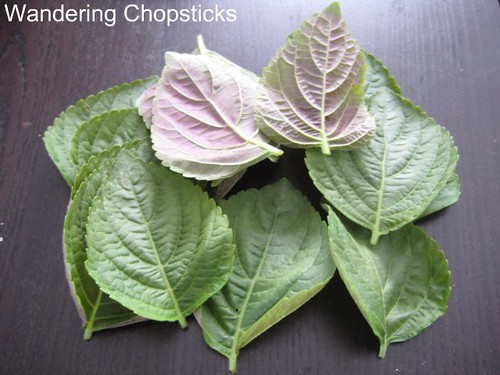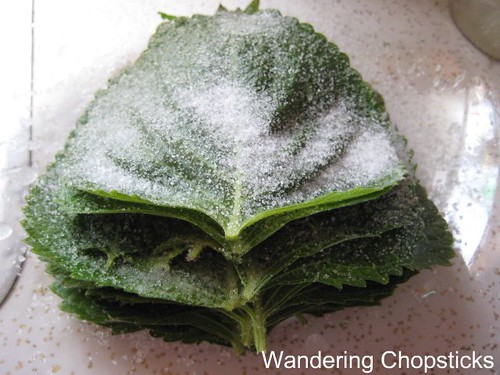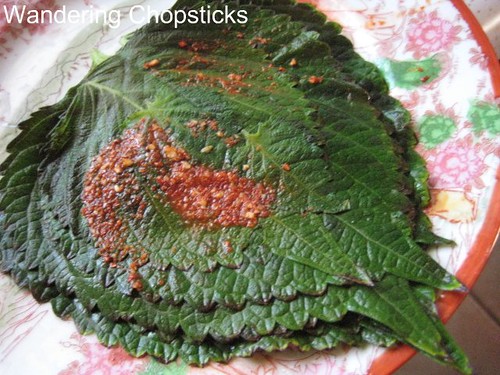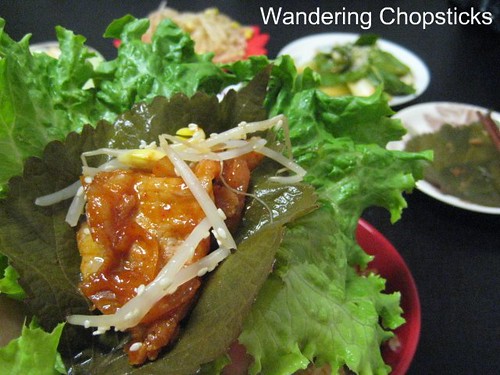
My youngest uncle grows a lot of
gaennip (Korean sesame/shiso/perilla leaves) in his garden so I decided to pickle them at the same time I made a batch of
kimchee. The only recipes I could find for
gaennip leaves were seasoning them with soy sauce and stuff and that didn't appeal to me. I know they're eaten fresh with lettuce wraps but there was quite an abundance of the herb this summer so I was brainstorming ways to preserve them. I'm not sure if Koreans eat this, although both of my Korean friends didn't say anything when I served it at dinner the other night, so it mustn'tve appeared too unusual.
Gaennip leaves taste, to me, like a more green version of
tia to (Vietnamese purple shiso/perilla) - slightly minty, slightly herbal. They're sometimes called sesame leaves but that's a misnomer as they're not related to the sesame family at all.

Again, this isn't such a precise recipe as I don't know how big your bunches of leaves are. I grabbed about half a dozen bunches.
Gaennip/Kaennip Kimchee (Korean Pickled Sesame/Shiso/Perilla Leaves)
Adapted from my recipe for
baechu kimchi (Korean pickled napa cabbage)
You'll need:
Half a bunches of
gaennip leaves or so, about a 2-inch height if you loosely stack them
Salt
2 tsp
mam ruoc (Vietnamese fermented shrimp paste)
2 tsp
nuoc mam (Vietnamese fish sauce)
2 tsp
gochujang (Korean chili paste), or more if you like spicy
2 cloves garlic, minced
1-inch knob ginger, minced
Pluck and wash
gaennip leaves. Salt in between every other leaf or so. Put the leaves in a bowl with just enough water to cover. Leave for several hours or overnight.

Drain leaves. Mix the rest of the ingredients together until you get a loose paste. Then using a butter knife, put a small schmear of the paste in between every other leaf, or every third leaf or so until all the chili paste is used up.

Fold up the whole stack and place into a jar. Adding water until the leaves are covered. Leave in a cool, dark place to ferment. This takes about a week.

To serve, I just leave a small plate of the leaves to be eaten as
panchan. Or wrap it up with some lettuce and
daeji bulgogi (Korean spicy pork), roll and eat.

Enjoy!
My other
gaennip recipe:
Bo Nuong La Tia To Dai Han (Vietnamese Grilled Beef with Korean Perilla Leaves)
*****
1 year ago today,
muop tom xao (Vietnamese loofah and shrimp stir-fry.












WC -- You're such a rock star. I'm Korean, and I haven't made half the Korean things you've made. Hmm, when I go home to California, I might have to do some cooking with my mom. Yikes, I now have a serious craving for some Korean food. It's your fault! E.
ReplyDeleteI think it called Rau Kinh Giới in Vietnamese.
ReplyDeleteE,
ReplyDeleteThanks! I bet your mom makes much better stuff. These are just the basics. I wanna tackle samgyetang (sp?) next. And head to Lawrence if you're craving Korean food.
KCQ,
Kinh gioi is called Vietnamese balm in English. It's lemony tasting to me.
The gaennip is closely related to tia to. Except the leaves are thicker and the taste is a little more pronounced.
I'm gonna do a herb chart soon so you can see the differences.
Thanks for this, I wandered over from Kirk's blog MMM-yoso. I'm going to attempt to grow these in my backyard in Arizona. Hopefully, they'll come out all right. I first had these from a can and I thought they were grape leaves. But now I find the stuff really interesting and I've been trying to find other uses for them. I didn't know about the marinated Shiso until I was watching a Japanese movie about grilled beef competitions.
ReplyDeleteJeffrey,
ReplyDeleteYou can try using these in my bo nuong la lot recipe. I've been meaning to do that myself.
i learned how to make kaenip from old korean mamas, so i really think of it as comfort food.
ReplyDeletethe fancy way to do it is layer each leaf in a container with chili, garlic, etc. between each one, but i think that's too much. i make it in quantity, because it keeps indefinitely (a year or so in the fridge brings out an excellent sour flavor):
kaenip leaves
garlic, bruised or totally crushed
green onion, chopped
kochu karu (coarse, kimchi style)
soy sauce/fish sauce
sugar (optional)
boil sauce, add everything but the leaves, which should be layered in container (or just packed in) and pour on hot boiling brine. leave at least one week. check it out.
Gedhun,
ReplyDeleteThanks for the recipe, but ummm, you did notice that that's basically my recipe right?
i'm korean and have always had perilla leaves in my garden. some of my favorite ways of eating them while growing up are the pickled kind that gehun gave the recipe for, as a wrap, as a fresh component in dolsot bibimbap (or any bibimbap), or chopped into long thin strips and cooked into a "juhn"... you know the kind that is usually made with just scallions or with some kind of fish and vegetables... its basically a flour, water, egg, pancake with vegetables (and/or seafood) mixed into the batter. And, depending on where you live, it might be a little late in the season now, but if you have some of the fresh blossoms i like to eat those fried as tempura or as a garnish
ReplyDeleteArtsychikiii,
ReplyDeleteI think I'll try making them into a jeon next. I've also seen them dipped in tempura batter, but never thought the blossoms were eaten as such!